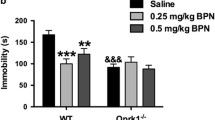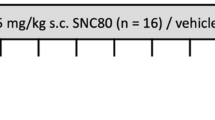Abstract
Rationale
Delta-opioid agonists produce a number of behavioral effects, including convulsions, antinociception, locomotor stimulation, and antidepressant-like effects. The development of these compounds as treatments for depression is limited by their convulsive effects. Therefore, determining how to separate the convulsive and antidepressant-like characteristics of these compounds is essential for their potential clinical use.
Objective
The present study tests the hypothesis that the rate of delta-opioid agonist administration greatly contributes to the convulsive properties, but not the antidepressant-like effects, of delta-opioid agonists.
Materials and methods
The delta-opioid agonist SNC80 (1, 3.2, and 10 mg kg−1 or vehicle) was administered to Sprague–Dawley rats by intravenous infusion over different durations of time (20 s, 20, or 60 min). Convulsions were measured by observation prior to determining antidepressant-like effects in the forced swim test.
Results
Slowing the rate of SNC80 administration minimized delta agonist-induced convulsions without altering the effects of SNC80 in the forced swim test.
Conclusions
These data suggest that delta agonist-induced antidepressant properties are independent of convulsive effects, and that it may be possible to eliminate the convulsions produced by delta agonists, further promoting their potential clinical utility.





Similar content being viewed by others
References
Abreu ME, Bigelow GE, Fleisher L, Walsh SL (2001) Effects of intravenous injection speed on responses to cocaine and hydromorphone in humans. Psychopharmacology (Berl) 154:76–84
Baamonde A, Daugé V, Ruiz-Gayo M, Fulga IG, Turcaud S, Fournié-Zaluski MC, Roques BP (1992) Antidepressant-type effects of endogenous enkephalins protected by systemic RB 101 are mediated by opioid δ and dopamine D1 receptor stimulation. Eur J Pharmacol 216:157–166
Baird TJ, Deng S-X, Landry DW, Winger G, Woods JH (2000) Natural and artificial enzymes against cocaine. I. Monoclonal antibody 15A10 and the reinforcing effects of cocaine in rats. J Pharmacol Exp Ther 295:1127–1134
Broom DC, Jutkiewicz EM, Folk JE, Traynor JR, Rice KC, Woods JH (2002a) Nonpeptidic delta-opioid receptor agonists reduce immobility in the forced swim assay in rats. Neuropsychopharmacology 26(6):744–755
Broom DC, Jutkiewicz EM, Folk JE, Traynor JR, Rice KC, Woods JH (2002b) Convulsant activity of a nonpeptidic delta-opioid receptor agonist is not required for antidepressant-like effects. Psychopharmacology (Berl) 164(1):42–48
Broom DC, Nitsche JF, Pintar JE, Rice KC, Woods JH, Traynor JR (2002c) Comparison of receptor mechanisms and efficacy requirements for δ-agonist-induced convulsive activity and antinociception in mice. J Pharmacol Exp Ther 303:723–729
Comer SD, Hoenicke EM, Sable AI, McNutt RW, Chang KJ, DeCosta BR, Mosberg HI, Woods JH (1993) Convulsive effects of systemic administration of the delta opioid agonist BW373U86 in mice. J Pharmacol Exp Ther 267(2):888–895
Detke MJ, Rickels M, Lucki I (1995) Active behaviors in the rat forced swimming test differentially produced by serotonergic and noradrenergic antidepressants. Psychopharmacology (Berl) 121:66–72
de Wit H, Dudish S, Ambre J (1993) Subjective and behavioral effects of diazepam depend on its rate of onset. Psychopharmacology (Berl) 112:324–330
Dykstra LA, Schoenbaum GM, Yarbrough J, McNutt R, Chang K-J (1993) A novel δ-opioid agonist, BW373U86, in squirrel monkeys responding under a schedule of shock titration. J Pharmacol Exp Ther 267:875–882
Filliol D, Ghozland S, Chluba J, Martin M, Matthes HWD, Simonin F, Befort K, Gavériaux-Ruff C, Dierich A, LeMeur M, Valverde O, Maldonado R, Kieffer BL (2000) Mice deficient for δ- and μ-opioid receptors exhibit opposing alterations of emotional responses. Nature 25:195–200
Greenstein YJ, Pavlides C, Winson J (1998) Long-term potentiation in the dentate gyrus is preferentially induced at theta rhythm periodicity. Brain Res 438:331–334
Hong EJ, Rice KC, Calderon S, Woods JH, Traynor JR (1998) Convulsive behavior of nonpeptide δ-opioid ligands: comparison of SNC80 and BW373U86 in mice. Analgesia 3:269–276
Jutkiewicz EM, Eller EB, Folk JE, Rice KC, Traynor JR, Woods JH (2004) δ-opioid agonists: differential efficacy and potency of SNC80, its 3-OH (SNC86) and 3-desoxy (SNC162) derivatives in Sprague–Dawley rats. J Pharmacol Exp Ther 309(1):173–181
Kollins SH, Rush CR, Pazzaglia, Ali JA (1998) Comparison of acute behavioral effects of sustained-release and immediate-release methylphenidate. Exp Clin Psychopharmacol 6(4):367–374
Larson J, Wong D, Lynch G (1986) Patterned stimulation at the theta frequency is optimal for the induction of hippocampal long-term potentiation. Brain Res 368:347–350
Law PY (2004) Delta opioid receptor signal trafficking. In: Chang K-J, Porreca F, Woods JH (eds) The delta receptor. Dekker, New York, pp 61–88
Negus SS, Butelman ER, Chang K-J, DeCosta B, Winger G, Woods JH (1994) Behavioral effects of the systemically active delta opioid agonist BW373U86 in rhesus monkeys. J Pharmacol Exp Ther 270:1025–1034
Pakarinen ED, Woods JH, Moerschbaecher JM (1995) Repeated acquisition of behavioral chains in squirrel monkeys: comparisons of a mu, kappa and delta opioid agonist. J Pharmacol Exp Ther 272:552–559
Pollack GM, Shen DD (1985) A timed intravenous pentylenetetrazol infusion seizure model for quantifying the anticonvulsant effect of valproic acid in the rat. J Pharmacol Methods 13:135–146
Porrino LJ (1993) Functional consequences of acute cocaine treatment depend on route of administration. Psychopharmacology (Berl) 112:343–351
Samaha A-N, Li Y, Robinson TE (2002) The rate of intravenous cocaine administration determines susceptibility to sensitization. J Neurosci 22(8):3244–3250
Schetz JA, Calderon SN, Bertha CM, Rice KC, Porreca F (1996) Rapid in vivo metabolism of a methylether derivative of (±)-BW373U86: the metabolic fate of [3H]SNC121 in rats. J Pharmacol Exp Ther 279:1069–1076
Tejedor-Real P, Micó JA, Smadja C, Maldonado R, Roques BP, Gibert-Rahola J (1998) Involvement of δ-opioid receptors in the effects induced by endogenous enkephalins on learned helplessness model. Eur J Pharmacol 354:1–7
Tsukada M, Aihara T, Mizuno M, Kato H, Ito K (1994) Temporal pattern sensitivity of long-term potentiation in hippocampal CA1 neurons. Biol Cybern 70:495–503
Acknowledgements
This work was supported by grants from the US Public Health Service Grants DA00254, T32 GM07767, and T32 DA07267.
Author information
Authors and Affiliations
Corresponding author
Rights and permissions
About this article
Cite this article
Jutkiewicz, E.M., Rice, K.C., Traynor, J.R. et al. Separation of the convulsions and antidepressant-like effects produced by the delta-opioid agonist SNC80 in rats. Psychopharmacology 182, 588–596 (2005). https://doi.org/10.1007/s00213-005-0138-9
Received:
Accepted:
Published:
Issue Date:
DOI: https://doi.org/10.1007/s00213-005-0138-9




